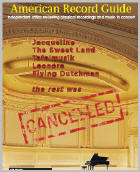Texte paru dans: / Appeared in: |
|
|
Outil de traduction ~ (Très approximatif) |
|
|
Reviewer: Todd
Gorman The release of this album was bolstered by an American concert tour before the coronavirus shut things down. Berlin's Academy for Old Music made their first trip to the United States in May of 2005 to critical acclaim and appreciative audiences. They returned to the US in 2008, 11, 14, 17, and 20. In February they were in North Carolina, Indiana, Missouri, and California. The symphonies are in G, W 180 from1758 and F, W 181 from 1762. The oboe concertos are in B–flat, W 164 and in E–flat, W 165, both from 1765. This work in B–flat is distinct from his Flute Concerto in B–flat, W 167 from 1751. The concertos are about twice the size of the symphonies, and they all have three standard movements. Everything here dates from his time in Berlin before the move to Hamburg.
A 19–page booklet has more inside than appears on first glance. The contribution from Peter Wollny is a bit gushy: "With great dexterity, he leads us through the rich succession of his musical ideas, past sublime gestures, deep abysses, and sensitive twists that miraculously traverse varied modulations." Once you've heard the music, you'd gush too. This is exactly the writing that inspired the next generation, including the Haydn brothers and Salieri. The last two pages offer a Bach discography from the Berlin Academy. Printed on the disc is a beautiful image of a flower that seems to be completely made up. It has the petals of a streaked or "broken" tulip and the center of a rose. It's taken from the 17th Century German painting used on the cover. | |
|
|
|
|
Cliquez l'un ou l'autre
bouton pour découvrir bien d'autres critiques de CD |
|




